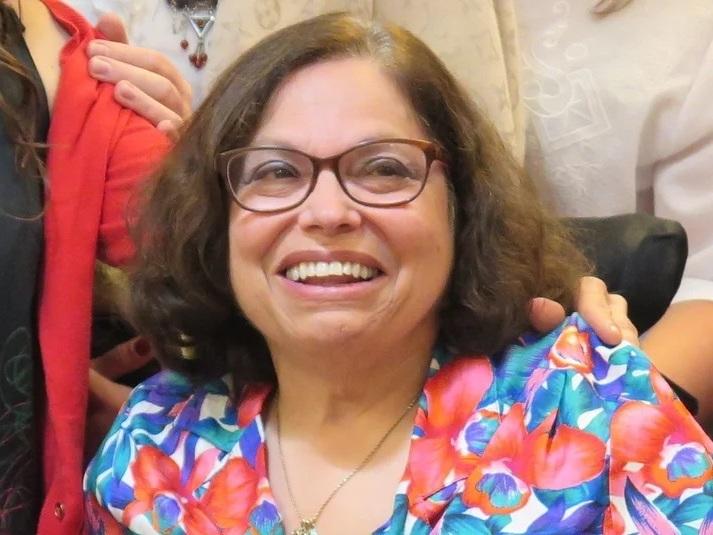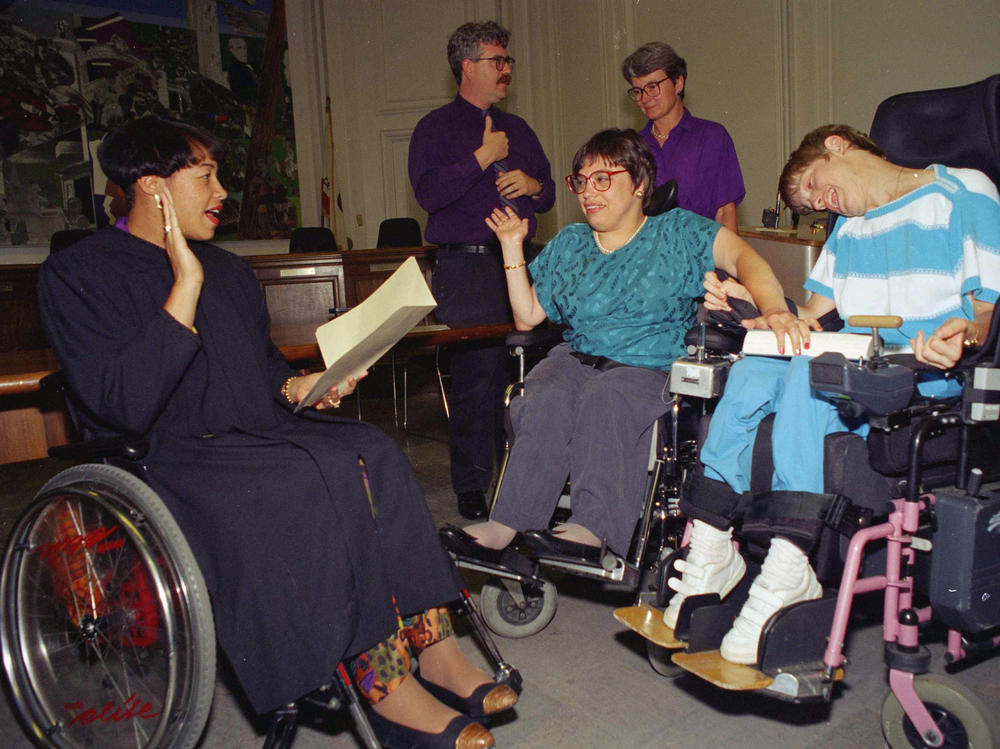Section Branding
Header Content
Activist Judy Heumann led a reimagining of what it means to be disabled
Primary Content
Judy Heumann was the first person I called when, in 1987, I reported my first story on disability rights. Judy, who contracted polio when she was 18 months old, gave me the quote that perfectly summed up that little-known civil rights movement.
"Disability only becomes a tragedy when society fails to provide the things we need to lead our lives — job opportunities or barrier-free buildings, for example," she said. "It is not a tragedy to me that I'm living in a wheelchair."
That idea seemed so unexpected and strange that my editors at a newsmagazine decided not to publish my story.
It was still a radical claim that disabled people didn't see themselves, or their conditions, as something to be pitied. Or that they insisted what most held them back wasn't their health condition but society's exclusion — maybe attitudes that they were less capable to do a job, go to college or find romance; or a physical barrier, like a sidewalk without a curb cut.
That reimagining of what it means to be disabled did gain traction over the years — the passage of the Americans with Disabilities Act just three years later in 1990 was a milestone — thanks to leaders like Heumann, who died suddenly on Saturday at age 75 at a hospital in Washington, D.C. She'd been hospitalized the previous weekend with breathing problems.
Heumann was a major American civil rights hero who remained little known until a flurry of attention in the last three years of her life. It started with the publication of her autobiography, Being Heumann: An Unrepentant Memoir of a Disability Rights Activist, co-authored with Kristen Joiner and released in February 2020, in the weeks just before the pandemic.
The celebration of Heumann took off shortly after with the release of the documentary Crip Camp: A Disability Revolution. Filmmakers James LeBrecht and Nicole Newnham found forgotten film of a summer camp in upstate New York for children with disabilities and used it to smartly explore issues of identity. The young people using wheelchairs and with various disabilities long to be included in a world that rejected them, but also find commonality and pride at a place that's exclusively for them. Heumann, who had attended Camp Jened from the time she was 8 and was a counselor at the time of the original film footage, quickly emerges as the documentary's star — a smart and self-confident organizer.
When the ADA marked its 30th birthday, in July of 2020, I and a lot of other journalists dialed up Judy. For NPR, I got Judy to share wisdom with a young activist, Imani Barbarin, who'd been born just four months before the ADA became law. Judy, who was working to spread knowledge of disability civil rights to the moment she died, noted the importance of the new directions of young activists like Barbarin who don't see the ADA as a capstone of rights, but as just a floor for achieving equality.
Other events of 2020 helped propel awareness of Heumann's work and the rise of the disability civil rights movement — the killing of George Floyd created discussion of diversity, equity and inclusion, with disabled people insisting it had to include them and the pandemic itself, one of the largest causes of new disability since the spread of polio.
Early in life, Heumann's wheelchair was called a fire hazard
In 1949, Judy, the daughter of a New York butcher and his wife, contracted polio. When she was 5 and it was time to go to kindergarten, her parents — German Jewish immigrants — went to register her but were turned away at the nearby public school.
It would create a fire hazard, the principal said, to let a girl in a wheelchair go to the school.
Her mother, Ilse Heumann, fought to end the isolating and erratic hours — just a few hours a week — of home instruction and eventually Judy was allowed into a school building.
Years later, Heumann graduated from college where she studied to become a teacher. Being a speech therapist was one of the few professions, she was told, open to a young woman in a wheelchair.
But again, she was deemed a fire hazard. This time, in 1970, New York City's Board of Education ruled that a teacher in a wheelchair would be unable to evacuate children during an emergency and denied her a teaching license.
Heumann, having learned from her mother's advocacy, sued. She got support in the local press. "You Can Be President, Not Teacher, with Polio," ran one newspaper story, noting the presidency of Franklin Roosevelt.
For that story, Heumann told the reporter: "We're not going to let a hypocritical society give us a token education and then bury us." Other disabled people around the country saw press coverage and wrote her letters detailing their own discrimination stories.
Heumann co-founded Disabled in Action, a protest group modeled on the work of Black civil rights activists, the women's movement and anti-Vietnam War protesters.
Heumann's activism expanded in the 1970s
In 1972, Heumann and a small group of DIA demonstrators shut down rush hour traffic on Madison Avenue outside President Richard Nixon's reelection campaign headquarters. They wanted to call attention to Nixon's veto of the Rehabilitation Act of 1972, which expanded programs to help people with disabilities.
Heumann moved to Berkeley, Calif., the center of a small but growing disability civil rights movement. (When, in 1990, I started writing a book, No Pity: People With Disabilities Forging a New Civil Rights Movement, I took my first reporting trip to Berkeley to spend time learning from Judy, Ed Roberts and other leaders.)
In 1973, Nixon did sign the Rehabilitation Act of 1973, which added milestone language to prevent discrimination against people with disabilities. But the Nixon and Ford administrations did not write the rules required to make that anti-discrimination language operative.
When the new administration of Jimmy Carter seemed unsure whether to act, disabled people took over a federal building in San Francisco. The protest, over 26 days in the spring of 1977, was one of the first actions of the rising disability civil rights movement to gain national press attention.
Heumann, then 29, emerged as a leader. When California congressmen convened a hearing at the occupied building and a federal official tried to reassure the protesters, Heumann did not let him off easy. "We will no longer allow the government to oppress disabled individuals. We want the law enforced. We will accept no more discussion of segregation," she said in a voice that quivered with emotion and indignation. "And I would appreciate it if you would stop shaking your head in agreement when I don't think you understand what we are talking about."
The protesters forced the Carter administration to implement Section 504 of the Rehabilitation Act, which specified that no government agency, or even a private business, that accepted federal funds could discriminate against someone on the basis of their disability.
Section 504 became a model for the ADA which would extend the principles of non-discrimination to all public accommodations, employment, transportation, communications and access to state and local government programs.
In her autobiography, Heumann wrote of her excitement to be present on the White House lawn when President George H.W. Bush signed the ADA into law on July 26, 1990. Although she had criticized the legislation that she thought didn't go far enough to help people, like her, who needed assistance from aides to live at home.
Heumann led various disability groups in California. In 1991, she met Jorge Pineda, at a disability conference, and they married the following year.
Heumann turned her efforts to working in the government and promoting global disability rights
In 1993, President Bill Clinton named Heumann — the woman who had once been declared a fire hazard too dangerous to be a student or a teacher — as assistant secretary of education, in charge of all of the nation's federal education programs for students with disabilities.
Later, in the Obama administration, she worked as a special assistant to Secretary of State Hillary Clinton, in charge of spreading ideas about civil rights across the world.
The disability civil rights revolution, which Heumann had helped launch in America, was now becoming a democracy export. Between 2000 and 2015, 181 countries passed disability civil rights modeled after the ADA (although many were laws with little power or follow up). In her hulking power wheelchair, Heumann traveled to more than 30 countries to spread the gospel of disability rights.
For the 25th anniversary of the ADA in 2015, I followed Judy at a State Department conference in Washington that brought 50 disabled advocates from 33 countries. They treated Judy like a rock star. They posed for selfies and brought her gifts. They sought her advice about closing down abusive orphanages for disabled children and about how to win equal rights for women with disabilities. "We are slowly changing the world," Judy told them.
Heumann was sunny and quick to smile, an optimist about the future. But she was also quick to call out discrimination.
Heumann appreciated the growing recognition of her work and the way demand for her time had grown starting in 2020. She was generous with that time and kept mentoring young activists around the world. She started a podcast and traveled or, during the pandemic appeared on Zoom, to keep up with a growing demand to hear her speak.
"We're simmering to a boil," she liked to say about seeing her work for the disability civil rights movement spread into the mainstream and across the globe.
Copyright 2023 NPR. To see more, visit https://www.npr.org.
Bottom Content


